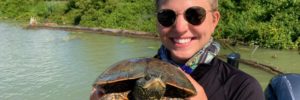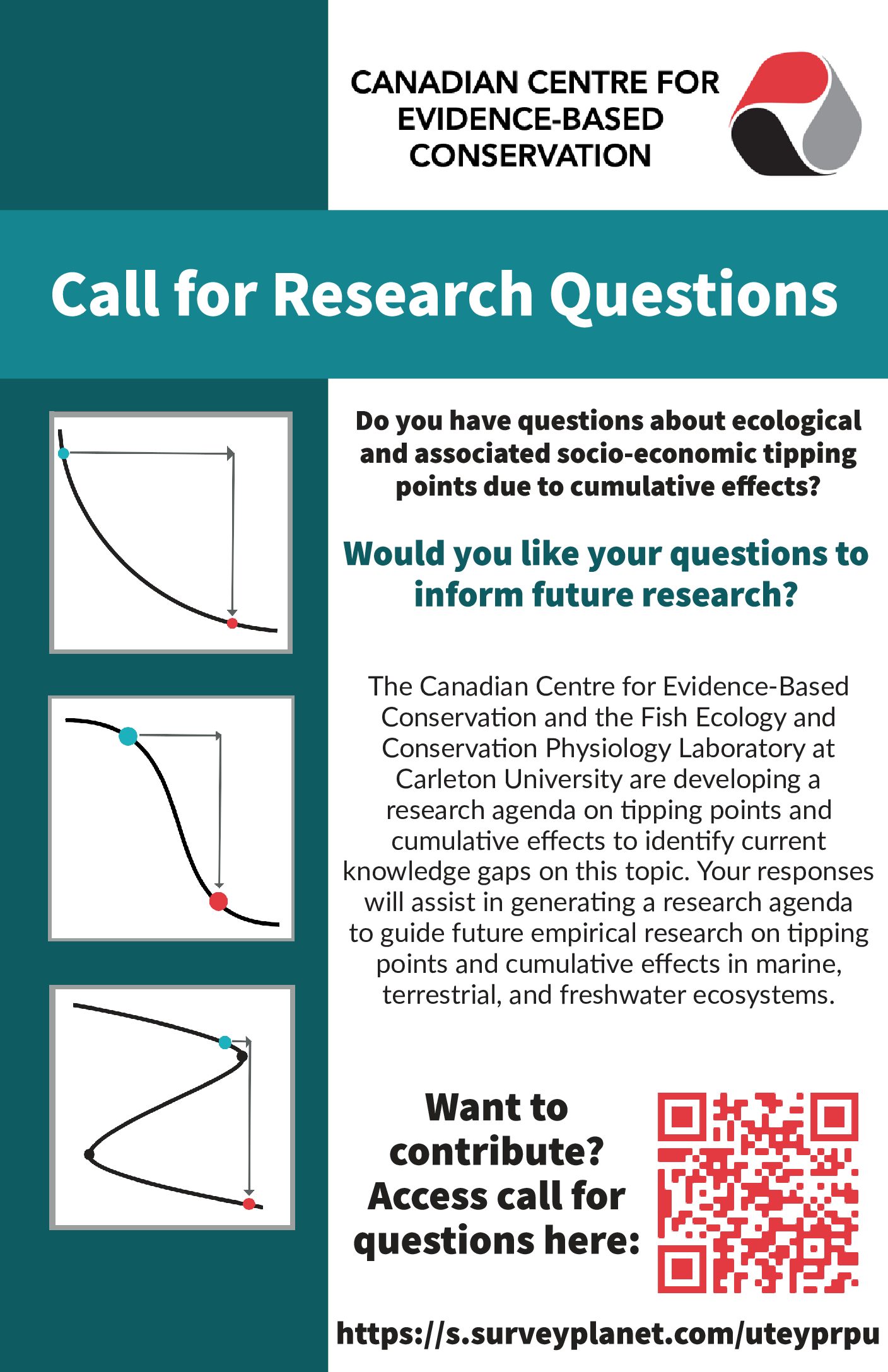A new paper, representing a large collaboration of aquatic scientists (Environmental Reviews), outlines the management and protection needed to support freshwater ecosystems and fisheries in our changing world.
Below, key principles are described using fishes as an example, but they generally apply to all aquatic organisms, including plankton, insects, crustaceans, mussels, reptiles, amphibians, birds and mammals.
Food chains transfer energy to fish, but some energy is lost at each link
Fisheries represent renewable resources, and the amount of biological resources that an ecosystem can produce is limited by the energy that it receives. This energy may come from the sun or in the form of plant and animal matter from surrounding ecosystems. Energy is lost as it travels up the food chain and ecosystems can support more prey than predators, which we tend to prefer as harvestable resources. This energy is lost because it is consumed by biological processes, like metabolism. The amount of fish that an ecosystem can produce depends in part on how much energy
is available, which sets limits on what we can harvest and these limits can be lower for predators that are high on the food chain.
Populations are regulated by reproduction, mortality, and growth
Fishes are constantly exposed to stress. For example, they may face unfavourable conditions, predators, parasites, or limited food sources. In combination, these can force fish to spend energy on surviving, rather than on growth and reproduction. If many individuals are dealing with a major stress, the size of a population can decrease through both death and/or a lack of reproduction. Many populations automatically adjust for changing conditions but they are not always able to. For example, if the weather is too cold during the spawning season, eggs and fry might not develop quickly enough to survive in the long run. Though we understand how some important species respond to major stressors such as low oxygen, we often do not know how populations will respond. This makes it important to protect fishes from stresses such as changes to their habitat.
Fish population size depends on habitat quantity and quality
Larger habitats can support more individuals, and may contain a higher diversity of habitat types that support a wide range of species. Higher quality habitats can produce more individuals because growth rates are higher and fish are more likely to reproduce successfully. Aquatic habitat can be described by its physical properties, including depth, flow, and substrate, and by chemical properties such as nutrient and oxygen concentrations. Temperature is also an important aspect of habitat quality, especially in freshwater. Even aquatic plants act as habitat for other aquatic species, providing both cover and food. These features combine to create habitat patches, and because each life stage of each species has different habitat needs, the quality of a habitat patch differs for each fish. We need to maintain a wide range of healthy habitats to support all of the species in the aquatic food chain.
Habitats need to be connected so that fish can find food and spawning grounds
For fish to complete all stages of their life-cycle, they must be able to move freely among habitat patches, especially those needed by different life stages. A common example of how this can be hampered is when dams block salmon from migrating to their spawning ground. Other species that migrate over shorter distances can also be blocked by dams or smaller barriers like culverts at road crossings. Levees can also prevent access to seasonal spawning grounds like floodplains. Floodplains are also key areas for the exchange of nutrients and energy between water and land, and this exchange is blocked by levees that prevent flooding. Fish passage ways can help fishes move across barriers but are relatively rare and are not always effective, especially for species that they were not designed to help. Anything we can do to reduce barriers to fish movement will help all species access the habitats they need at each important stage of their life cycle.
Freshwater species and their habitats are linked to surrounding watersheds
Watersheds, the land surrounding the water, are vitally linked to water bodies. They provide nutrients and energy, which make their way to the water through runoff (when rain travels over land to the water). Nutrients in water are important for the growth of aquatic species, and come from the surrounding land through runoff. Too many nutrients can cause major changes to the aquatic environment such as toxic algae blooms. Runoff can also carry sediments that change aquatic habitats, sometimes creating beneficial spawning beds but other times smothering them, depending on the size and amount of sediment. Cloudy water from increased sediment is often caused by improper land management that leads to soil erosion. Changes to land use in the watershed can also change stream flow; removal of trees and increased urban development lead to increased runoff, causing more frequent and extreme floods, and more erosion within the stream. Changes to riparian zones, the area of land immediately beside the water, can have the greatest effects on water bodies because this area acts as a buffer between watersheds and aquatic systems, and can slow and filter runoff. The riparian zone provides a variety of resources like leaves, wood, and insects and also shades streams, helping to maintain important cold water habitat. In return, aquatic ecosystems contribute resources to terrestrial systems when animals feed on aquatic species. These exchanges can be quite large and important, such as when thousands of salmon migrate upstream and die after spawning and replenish nutrients back into the land. To protect aquatic habitats, we also need to protect the lands that surround them, as all land is connected to a watercourse somewhere.
Biodiversity helps ecosystems deal with change and stress
Protecting biodiversity not only promotes the survival of species but has many benefits to the environment as a whole. Biodiversity includes variety in genetics, species, and ecosystems across a region. Within a body of water, there are many species and some of these may even have several distinct and separate populations due to location or genetics. If any of these populations or species are extirpated (eliminated from an area, but not globally extinct), the biodiversity of the waterbody is reduced. This can have many effects on the other species that remain in the system. Each species uses different resources in the system, and may provide resources to other species. Many species have similar roles in an ecosystem, and compete with each other. The different species in an aquatic system have evolved together, in part because each makes sure that the others do not take over and use up all of the resources. This competition leads to stability in the ecosystem, and keeps it from changing dramatically when a stress occurs. Just as terrestrial ecosystems can change from forests to grasslands after a fire, aquatic systems can change states. Humans generally prefer clear water with lots of aquatic plants over muddy water covered in algae. Biodiversity can provide a form of insurance against shifts to an unwanted state. Ecosystems with many species that have similar roles can also be resilient to stress. Just as our cities have back-up power generators and detour routes in case of emergencies, similar species in an ecosystem act as back-ups for each other. When one species declines, another can increase in population to fill the gap that was left, often preventing major changes to all other species in the food web. A diverse group of species may be able to more completely use the energy and nutrients in an ecosystem, leading to bigger fish populations than in less diverse systems. More species are not always better though, and introduced species can disrupt relationships between native species. In general though, there are many advantages to diverse ecosystems, and ensuring sustainable fisheries requires the protection of all species in an ecosystem.
Local systems are affected by regional and global change
To manage and protect local water bodies and the fishes they contain, changes occurring beyond the watershed must also be considered. Pollutants like heavy metals and acid rain can be carried across regions, and many are now found even in remote lakes and rivers. Climate change is having many effects on aquatic systems, with changes to temperature perhaps being most strongly felt by freshwater species. Because fish depend on the right temperature for growth, and because most cannot move north as temperatures warm, the species found in lakes and rivers are quickly becoming mismatched with the conditions that are developing there. But temperature is not the only thing changing; with increasing temperature, we are seeing more evaporation and more rain. This leads to some areas drying out, and others becoming wetter. Although more rain would at first seem good for freshwater species, it can increase the occurrence and severity of flash floods. Even without major flooding, increased water flow can lead to greater stream bank erosion. The time of year that high flow events happen is changing too, which can make it difficult for species that need high flows at a certain time of year to spawn. Even more complex changes are occurring- when warming climates meet acid rain, the amount of dissolved organic carbon in lakes is reduced, which leads to more UV-B light. Like us, fish (and especially their eggs) are harmed by UV-B light, adding another stress to face. If we do not account for these larger changes when working to protect local fish populations and habitats, the success of our efforts may be threatened.
Fish face many stresses that layer on top of each other
So far, we have listed many of the different stresses that fish face, but these do not act in isolation. While temperatures warm, habitats are lost or changed, movements are blocked by dams and levees, toxins are deposited, and nutrient levels are climbing higher than some systems can handle. Not all ecosystems are being severely changed, but none are unaffected. We are beginning to understand how individual changes affect ecosystems, but we know little about how they act together to change things overall. Some may balance each other out. For example, temperatures that lower growth rates may be balanced by increased energy and nutrients. But these can also act synergistically, in that the combined effects of these changes might be worse than their individual effects. Using the same example, if too many nutrients lead to algae blooms, then oxygen is used up when the algae decomposes. Warm water holds less oxygen to begin with, making the lack of oxygen in this scenario more severe. Small changes that alone would have little effect can combine to create a major change. For instance, the construction of one dock on a lake would likely do little damage, but if the entire lakeshore is transformed to lawns and cottages, too much habitat is lost. Without a natural riparian zone, the lake no longer receives as many insects or woody debris, and there is nothing left to filter runoff. The same can be said for roads that cross small streams. A single bridge does little to change a river network, but when thousands of crossings are built throughout a watershed, fish may no longer be able to move long distances, and the roads can increase runoff and the amount of sand, salt, and gravel that winds up in the streams.
Our actions can affect the evolution of fishes, making changes difficult to reverse
Native populations of species have the advantage of adapting over thousands of years or longer, to thrive in the unique conditions of the water bodies where they occur. We are rapidly changing the nature of our native fish populations by changing the processes through which they evolve. If we stock hatchery fish or closely related species on top of native fish, they can breed together and mix their genes. These new genes often do not represent traits that are ideal for local environments, and can reduce the overall match between the wild population and local condition. We also tend to act as a very strong selective force on many fish populations. Like wolves hunting the weakest elk in the herd, natural predators seek out slow and weak fish, allowing the fittest fish to survive and keep the population strong. But like elk hunting, the biggest, strongest individuals are targeted when fishing, either for recreation or for commercial harvest. This can lead to the evolution of smaller, slower-growing fish populations that mature earlier and do not reproduce as successfully. Natural selection acts even quicker and stronger when a large proportion of the population is lost. In this situation, the genetic makeup of a population can change dramatically over just a few generations. Even if fishing pressure is reduced or stopped, these changes can be extremely slow to reverse because selection is not as strong in the opposite direction. These changes are worth working to prevent, because a loss of genetic diversity is a form of biodiversity loss that is hard to reverse. When changes lead to slower growth and smaller fish that mature earlier, the overall amount of resources that a fishery provides can be reduced, limiting the sustainable benefits that it provides.




